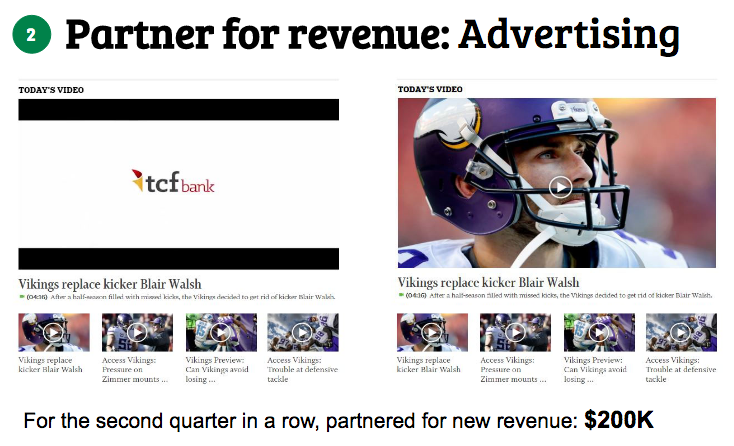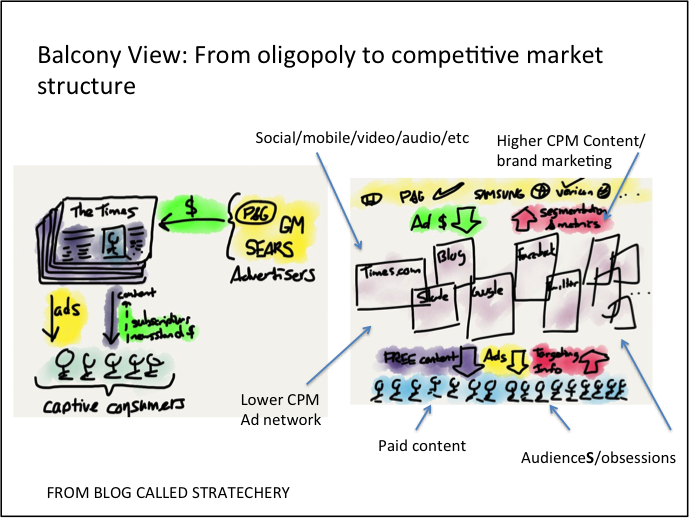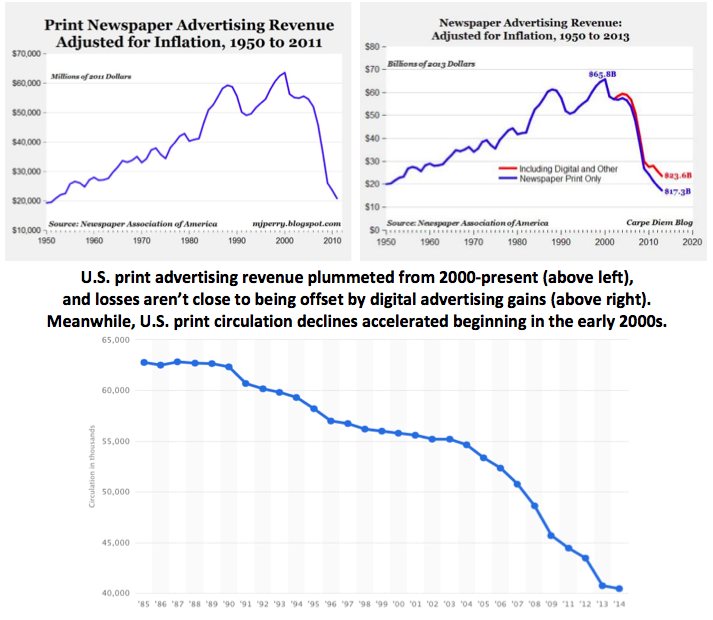Why “funneling occasional users to habitual and paying loyalists” is Table Stakes
Douglas K. Smith, Quentin Hope, Tim Griggs, Knight-Lenfest Newsroom Initiative,This is an excerpt from “Table Stakes: A Manual for Getting in the Game of News,” published Nov. 14, 2017. Read more excerpts here.
Why this is Table Stakes
a) Audiences want and need well told, trusted local news and information – but have lost the habit of paying for it
People of all ages want and need the local news and information required to (1) be informed citizens in the places they live; (2) make good choices about the necessities in their lives (e.g. finding jobs, locating affordable homes or apartments, choosing among education options for their kids and/or themselves); and, (3) enhance the quality of their lives beyond necessities (e.g. where to eat, where to dance, where to play). Audiences also value well-told stories that provide context for staying informed.
This is true even of “millennials,” a generation wrongly labeled apathetic and disconnected. In 2015, for example, API reported that 85% of millennials say keeping up with the news is important to them, 69% get news every day, and 45% say they follow five or more “hard news” topics.
Audiences still trust local news organizations. Pew, for example, reports in 2016 that 82% of folks say they trust the information they get from local news organizations, a number higher than national news organizations, friends and family, and social media news sources.
Yet, beyond the declining number of mostly older print subscribers, audiences have lost the habit of paying for news content. Too many consumers believe that ‘if the news is important, it will find me.’ Many (not all) consumers of all ages do understand that information is not cost free to create; and, that news enterprises need revenue to pay employees to create, produce, market, distribute, sell and otherwise support quality journalism. Many – again not all – express a willingness to pay for local news. And 40% of millennials do pay for some forms of news products and services. Still, today’s audiences have zillions of choices – including one another through social – for where to get news. And, they have more than decade of experience of not having to pay.
b) Engaged audiences create more and better opportunities for higher value local advertising and sponsorship
High volume, scale strategies that convert digital dimes and mobile pennies into big revenue streams are not possible for metro, local or regional news enterprises who cannot escape their geographic footprints. But reaching more of the relevant people locally opens doors to more lucrative advertising and sponsorship. The ability to offer local businesses access to the specific, engaged audiences those businesses seek – especially when you can provide rich data about those audiences – is the central competitive advantage a metro news organization can provide when it comes to advertising.
One example: The Star Tribune’s sponsorship package with TCF Bank for its special Vikings season subscription, which the Strib wove into its Vikings coverage, is a unique value proposition to TCF and delivered meaningful new revenue:

c) Revitalizing the habit to pay for content – as well as attracting and engaging the audiences advertisers seek to reach – are tough jobs in a media-scape cluttered with high numbers of options and platforms
Ben Thompson, who writes the Stratechery blog (link: https://stratechery.com/), illustrates the difference between yesteryear’s simple market context for metros versus today’s complex and difficult one:

Pay particular attention to the ellipsis – the “…” – following the content providers Ben has in his sketched rectangles. That “…” is more than just “et cetera.” It arguably indicates ‘to infinity’ because it is impossible to count the number of content providers vying for those seeking news and information.
On top of which, here’s what’s missing from Ben’s picture: the myriad platforms and devices through which consumers get news and information as well as the rapid migration across those devices and platforms. Today, 72% of Americans say they get news via mobile device and of those who get news on both desktop/laptop and mobile devices, more (56% to 42%) prefer mobile. Further, 62% of Americans get news on social media, dominated by Facebook. Digital news discovery is more push (it finds you) than pull (you seek it out). Similarly, consumers often have less loyalty to specific news brands.
The shift in news consumption dynamics is clear. Users have more options and more sources to get news, and no longer have the same need to seek it out let alone pay for it.
Moreover, in a social/mobile world dominated by powerful platforms (Facebook and others), it’s more difficult than ever to connect user behavior to news enterprise economics. It’s not just the shift to social/mobile – it is also the question of whether any particular user clicks on a link and goes to the news enterprise site – or doesn’t click on that link and stays in, say, Facebook. Or, even more difficult, stays in Facebook or another platform because the platform’s rules require that. If audiences don’t leave Facebook/others, then how do creators of that news monetize content?
d) Only today’s metro newsrooms in collaboration with technology and tool-building colleagues and partners can attract and retain the audiences that pay for content and are desired by advertisers – no one else can do this
In today’s digital context, the objectives of circulation and distribution have moved into the newsroom. They are now the newsroom’s job to get done. In the print era, circulation, marketing and distribution had the job of ensuring consumers paid for content. This is still true today for the platform we call ‘newspapers.’ But, all that changes when audiences seek digital as opposed to printed content. As described in Table Stakes 1, 2 and 3, metro newsrooms – along with technology colleagues – must hold themselves accountable for serving targeted audiences with targeted content (TS#1), publishing on the platforms used by chosen audiences (TS#2), and producing and publishing continuously (TS#3) to meet audience needs for local news, information and connectedness.
Even these three Table Stakes, though, are not enough to get in the game of today’s multiplatform, digital realities. Newsrooms also must actively and aggressively hold themselves accountable for building new audiences, deeply engaging audiences they already have, and re-introducing audiences to the lost habit of paying for content. Yes, folks beyond the newsroom must join in this effort: marketing, publishers, and especially technology and so forth. Those efforts, though, cannot succeed in the face of newsrooms whose journalists fail to go beyond traditional notions of reporting and editing. Newsrooms must create such great local news experiences that local audiences are convinced to pay for (and recommend) their content and products, through delightful user experiences, valuable benefits/features/functions/utility, important community services and more. Further, newsrooms must play a key role in finding additional ways to derive revenue from the audiences they build as well as show local advertisers the added value (at a higher cost) of being associated with such engaged, loyal audiences.
e) Time – accelerated by deteriorating economics – is running out
No enterprise of any kind – no nonprofit, no governmental enterprise, and no private sector enterprise – can exist without cash to pay for operations as well as innovation. For metro, local and regional news enterprises this needed cash is declining at alarming rates.
